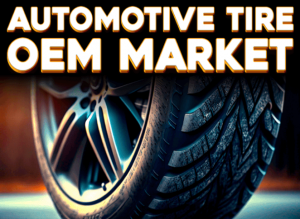Automotive Tire Market is projected to grow to USD 82.77 billion by 2032, exhibiting a CAGR of 7.4%
Key Companies Covered in the automotive tire market report are Bridgestone Corporation, Michelin, Goodyear Tire and Rubber Company, Sumitomo Rubber Industries
Key growth drivers include increasing global vehicle production, a shift toward fuel-efficient and high-performance tires, and the integration of advanced technologies like smart tires with embedded sensors. These innovations are enhancing real-time monitoring, improving safety, and reducing maintenance costs—making them increasingly attractive to both consumers and manufacturers.
Automotive tire market driven by a strong automotive manufacturing base and growing adoption of personal mobility solutions in countries like China, India, and Japan. In the OEM segment, passenger cars dominated the global market, accounting for 59.93% share in 2024, thanks to the rising sales of electric and hybrid vehicles and the growing consumer preference for original equipment that offers optimal performance and durability.
Get a Free Sample Research PDF: https://www.fortunebusinessinsights.com/enquiry/request-sample-pdf/automotive-tire-market-101594
Key Players and Competitive Landscape
The global automotive tire market is highly competitive and fragmented, with major players focusing on R&D, strategic partnerships, and sustainable production practices to stay ahead. Prominent companies operating in the market include:
• Bridgestone Corporation (Japan)
• Michelin (France)
• Continental AG (Germany)
• Goodyear Tire and Rubber Company (U.S.)
• Sumitomo Rubber Industries (Japan)
• Hankook (South Korea)
• Pirelli (Italy)
• Yokohama Rubber Company (Japan)
• Toyo Tires (Japan)
• Giti Tire (Singapore)
• Maxxis (Taiwan)
• ZC Rubber (China)
• MRF Tires (India)
• Apollo Tyres (India)
These players are investing heavily in eco-friendly materials, connected tire systems, and EV-compatible designs, aligning with broader trends in the automotive and mobility sectors.
Market Trends to Watch
The rising popularity of run-flat and all-season tires is reshaping consumer expectations and OEM product strategies across global markets. Run-flat tires offer the advantage of continued mobility even after a puncture, making them especially attractive for urban drivers and premium vehicle segments. Similarly, all-season tires are gaining ground due to their versatility and cost-efficiency, eliminating the need for seasonal replacements in moderate climates. As consumers prioritize convenience, safety, and value, tire manufacturers are responding with innovative tread designs and multi-season compounds to meet evolving needs.
Another key trend is the growing demand for EV-compatible, low rolling resistance tires designed to enhance range efficiency and reduce energy consumption. With the surge in electric vehicle (EV) adoption, tire makers are engineering lighter, quieter, and more durable solutions to support EV performance requirements. In parallel, the expansion of online tire retailing and B2B platforms is streamlining distribution channels and improving customer access. E-commerce adoption is accelerating across both developed and emerging markets, while fleet operators and workshops benefit from bulk procurement via digital platforms. Moreover, there is a clear industry-wide emphasis on sustainable sourcing, tire recycling, and circular economy initiatives, as manufacturers commit to reducing environmental impact through eco-friendly materials, retreading programs, and innovative end-of-life tire processing solutions. These trends are expected to play a crucial role in shaping the competitive dynamics of the global automotive tire market over the coming decade.
Quick Buy - Electric Ship Market Research Report: https://www.fortunebusinessinsights.com/select-license/101594
Automotive Tire OEM Market Segmentation Analysis
The automotive tire market is segmented across multiple dimensions including vehicle type, tire design, distribution channel, and geography, allowing manufacturers and stakeholders to better target consumer demand and optimize supply chain strategies. By vehicle type, the market is categorized into passenger cars, light commercial vehicles (LCVs), heavy commercial vehicles (HCVs), and electric vehicles (EVs). Among these, the passenger car segment dominates the market, driven by increased vehicle ownership, rising middle-class income, and urbanization. Meanwhile, the growing shift toward electric and hybrid vehicles has spurred demand for EV-compatible tires that offer low rolling resistance, enhanced durability, and quieter performance. The commercial vehicle tire segment is also expanding due to the rise in logistics, e-commerce, and industrial transportation globally.
In terms of tire design, the market is segmented into radial and bias (cross-ply) tires, with radial tires accounting for the majority share owing to their superior fuel efficiency, longevity, and heat dissipation characteristics. The market is further classified by distribution channel into OEM (Original Equipment Manufacturer) and aftermarket segments. While OEM demand is influenced by vehicle production trends, aftermarket sales are driven by replacement cycles, road conditions, and consumer preferences for premium or performance-enhancing tire options. Geographically, the market is segmented into North America, Europe, Asia Pacific, Latin America, and the Middle East & Africa. Asia Pacific leads the global landscape due to its large-scale automotive production hubs, cost-competitive manufacturing, and rising regional demand, especially in China and India. Each of these segments plays a vital role in shaping product innovation, pricing strategies, and overall market competitiveness.
Key Industry Developments:
January 2023- Sumitomo Rubber Industries collaborated with Global Data Service Organization for Tyres and Automotive Components (GDSO) to enhance individual tire identification and management systems to enhance tire traceability. The tire manufacturer will also design a database enabling users to access data on the company's tires using RFID technology.
October 2022 – Hankook Tire launched Smart iON AU06+, the first Truck and Bus Radial tire in its iON product portfolio for premium EVs in the Korean market. The Smart iON AU06+ is the latest addition to its iON tire family, which includes winter and summer tires for passenger EVs.
Related Reports:
Vehicle Access Control Market Size, Share, Growth Report, 2032
Automotive Fascia Market Size, Share, Growth Report, 2032
Ashwin Arora
Fortune Business Insights™ Pvt. Ltd.
+ +1 833-909-2966
sales@fortunebusinessinsights.com
Legal Disclaimer:
EIN Presswire provides this news content "as is" without warranty of any kind. We do not accept any responsibility or liability for the accuracy, content, images, videos, licenses, completeness, legality, or reliability of the information contained in this article. If you have any complaints or copyright issues related to this article, kindly contact the author above.
Magnetic Eyelashes Market Set to Grow Through 2032: Insights by Material Type, Color, Distribution Channel, Region
ntam Launches Tala – the World’s First AI Travel Influencer for the MENA Region, Cognivai at Arabian Travel Market 2025
EBC Profunde su Compromiso con United to Beat Malaria con una Nueva Asociación y su Primer Patrocinio una Carrera de 5K
Kalendarium
Więcej ważnych informacji
 Jedynka Newserii
Jedynka Newserii

 Jedynka Newserii
Jedynka Newserii

Ochrona środowiska

Zielona transformacja wiąże się z dodatkowymi kosztami. Mimo to firmy traktują ją jako szansę dla siebie i Europy
Bez zaangażowania największych firm, które ograniczają własny ślad węglowy, będzie trudno o transformację energetyczną. Jak wynika z danych Europejskiego Banku Inwestycyjnego, w ubiegłym roku 61 proc. przedsiębiorstw z UE zainwestowało w walkę ze zmianą klimatu. Choć z tymi inwestycjami wiążą się zwykle ogromne koszty, część firm traktuje je jako szansę na podniesienie swojej konkurencyjności. Wśród znaczących korzyści podnoszą też kwestię zmniejszania zależności od dostaw surowców energetycznych z innych krajów.
Prawo
Rolnicy z Wielkopolski i Opolszczyzny protestują przeciwko likwidacji ich miejsc pracy. Minister rolnictwa deklaruje szukanie rozwiązań

W czwartek 24 kwietnia pracownicy towarowych gospodarstw rolnych z województw wielkopolskiego i opolskiego protestowali przed Ministerstwem Rolnictwa i Rozwoju Wsi w Warszawie. To już kolejny – po poznańskim – protest, który ma zwrócić uwagę na opieszałość urzędników w związku z zagospodarowaniem zwracanych do Zasobu Skarbu Państwa dzierżawionych gruntów, na których dziś prowadzona jest działalność rolnicza. Minister Czesław Siekierski przyjął delegację pracowników, która przekazała petycję z postulatami wymagającymi pilnych działań urzędniczych.
Prawo
W połowie maja pierwszym pakietem deregulacyjnym zajmie się Senat. Trwają prace nad drugim pakietem

Zgodnie z zaplanowanym porządkiem obrad na posiedzeniu 14–15 maja Senat zajmie się pierwszym pakietem deregulacyjnym, przygotowanym przez Ministerstwo Rozwoju i Technologii. Przyjęty w ubiegłym tygodniu przez Sejm dokument zawiera około 40 rozwiązań, które mają ułatwić prowadzenie biznesu. W ciągu kilku miesięcy efekty mają być odczuwalne dla przedsiębiorców. Jednocześnie trwają już prace nad kolejnymi propozycjami deregulacyjnymi.
Partner serwisu
Szkolenia

Akademia Newserii
Akademia Newserii to projekt, w ramach którego najlepsi polscy dziennikarze biznesowi, giełdowi oraz lifestylowi, a także szkoleniowcy z wieloletnim doświadczeniem dzielą się swoją wiedzą nt. pracy z mediami.





![Europejskie miasta planują wzrost inwestycji w infrastrukturę społeczną. Wydatki na niskoemisyjny transport wciąż są niewystarczające [DEPESZA]](https://www.newseria.pl/files/1097841585/panel-dotacje-foto,w_85,_small.jpg)


.gif)



